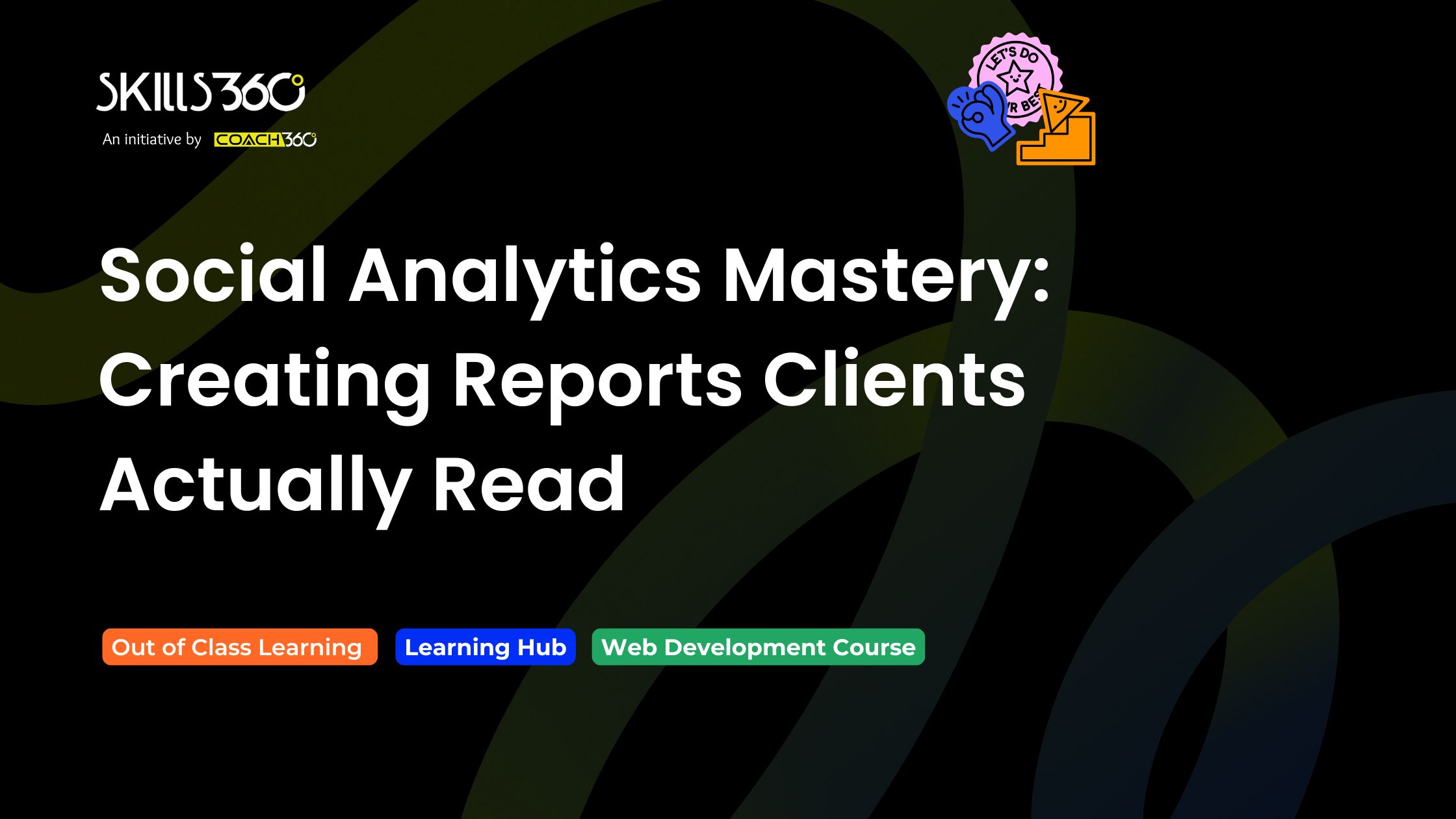- Featured article
- People at Skills360 03 - Nov 2025 | 12 min read

Everywhere, marketers, agencies, and independent contractors deal with the same problem: clients claim to want analytics, but they hardly ever read them. Lack of data is not the issue. It's a lack of narrative, context, and clarity.
Social media managers are more than just content producers in the modern digital environment; they are also insight translators. However, all too frequently, social analytics reports wind up being overflowing with screenshots, pointless data, and technical terms that confuse rather than educate clients.
At Skills360, we consider reporting to be an art form that blends analytical accuracy with the capacity to create an engaging narrative. We teach professionals how to do more than just measure data in our social analytics and marketing courses.
So how do you create a report that clients will read and, more importantly, take action on? Let's investigate.
Every report begins with a target audience. And no, it's your client, not your Instagram followers.
Prior to exporting metrics, inquire:
A CEO wants to know if their social investment is generating leads, not the reply rate of every comment. In the meantime, trends in engagement, content reach, and audience demographics may be of interest to a marketing manager.
Your report instantly gains value when it takes into account the priorities of your reader.
Expert advice: Begin your report with a brief overview page that explains:
It is easy to use, human, and immediately beneficial.
There are metrics everywhere. Results are uncommon. A great report tells your client why something happened, while a good report tells them what happened.
Social media managers who include narrative context in their reports see 40% higher client satisfaction scores, according to a HubSpot agency benchmark study.
Can you see the difference? You're providing an insight rather than merely a statistic. Without interpretation, data is just noise. Making it sing is your responsibility as an analyst or strategist.
Visuals are always remembered by clients, but numbers are rarely.
Your social analytics report should therefore read less like a spreadsheet and more like a visual narrative. Consider using heat maps, trend lines, and charts, but only when they provide additional clarity.
You can visualize performance in a clear, narrative-driven manner with the aid of programs like Google Data Studio, Canva, or even PowerPoint. Reach, engagement, conversions, and insights should all flow logically from one another.
Additionally, always clearly label. Steer clear of small text, duplicate logos, and dashboards that are too complicated. The general rule is that a chart isn't good if it requires explanation.
One of the biggest blunders involved in social analytics is giving the client too much stuff. Each platform has a ridiculous amount of metrics: reach, impressions, saves, shares, link clicks, watch time, follower growth, engagement per post, on and on. Your clients do not need them all.
Performance indicators (KPIs) and diagnostic metrics are distinguished by a strong analytics framework; while the former measure success, the latter provide an explanation for it.
Sift through the data and choose metrics that apply to your client's goals.
For example:
An e-commerce brand: clicks, conversions, cost per acquisition.
A lifestyle brand: engagement rate, saves, sentiment.
A B2B company: impressions, shares, inbound messages.
By sifting through the noise, you can create reports that are strategy-based, not stat-based.
I’ll share a little secret that many marketers miss: People want to feel informed, not overwhelmed. They aren’t data analysts, they are decision makers. They want to know what that data means in real life.
So the next time you present numbers, include even one sentence of context:
Doing this does not only make your report more palatable, it builds trust. It shows your clients you are pro-active, analytical, and care about return.
The best social analytics reports have a beginning, middle, and end.
Beginning: Where were we last month?
Middle: What did we do this month?
End: What did we learn and what's next?
When your report has a narrative arc, it feels like a story, and your audience naturally follows along. The audience sees the progress, the challenges, the victories and not just data in a vacuum.
Transitions like “As a result,” “This indicates,” or “We observed a shift,” can connect your points. This technique of storytelling can change the tone for the audience while maintaining fidelity by prompting a clearer understanding of the situation.
Automation tools like Sprout Social, Hootsuite, or Meta Business Suite can make your reporting life easier. But automation should never replace analysis.
At Skills360, we often teach learners how to blend automation with insight, using tools to gather the numbers but adding human intelligence to interpret them. That’s what makes the difference between a mechanical report and a meaningful one.
Often, marketers want to brush over lesser performing areas. However, honest reporting is what builds better relationships with clients.
If your engagement is down, let them know what has happened and what you plan to do differently next time. Perhaps the audience changed, and perhaps the frequency of content changed, either way, demonstrating your thinking, offers them professionalism and confidence.
When clients see that you can find weaknesses and develop solutions, they trust your leadership even more.
Contemporary journalism ought not to simply encapsulate what has gone before. It should look into the future.
We urge you to inject smatterings of predictive commentary into your reports. For instance:
Inserting statements about the future demonstrates initiative and gives your clients a sense that you care and are one step ahead.
The most meaningful reports are not "end-of-month tasks," they are strategy tools.
Use your analytics to help determine:
When you can merge reporting with strategy, you’ve made your position indispensable. Your report is no longer a report, it becomes your plan.
Social analysis today involves much more than simply counting likes. It’s about examining the context in which people engage with content, how algorithms extend or amplify certain content, and understanding aspects of long-term loyalty.
That is why at Skills360, our training programmes rise above the needs associated with reporting. Learners are trained on performance analysis, creative insight application, data-driven storytelling and communicating. The skills to turn numbers into a narrative.
Businesses that train their teams in social analytics and reporting see a 34% increase in perceived client value, reinforcing how essential these skills have become in today’s market.
An excellent social analytics report inspires action rather than merely sitting in a client's inbox. It attracts attention because it provides answers to the important questions: What did we learn? What comes next?
When data is properly translated, it becomes a narrative of development, education, and guidance. Clients remember that, and it's what creates enduring relationships.
Keep in mind this straightforward maxim as you hone your reporting abilities: confidence grows with clarity. Your credibility increases with the clarity of your story.
And Skills360 is the place to start if you're prepared to advance your knowledge of analytics and digital marketing. Here, data turns into strategy, and strategy turns into success.


Get curated emails on out of class learning and work on your skills on your free time.